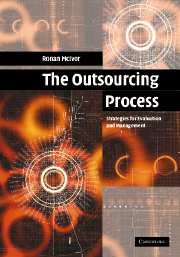Book contents
- Frontmatter
- Contents
- List of figures
- List of tables
- List of illustrations
- Acknowledgements
- 1 Introduction
- 2 The trend towards outsourcing
- 3 Theoretical influences on outsourcing
- 4 The outsourcing process: a framework for evaluation and management
- 5 Determining the current boundary of the organisation
- 6 Activity importance analysis
- 7 Capability analysis
- 8 An analysis of the strategic sourcing options
- 9 Developing the relationship strategy
- 10 Establish, manage and evaluate the relationship
- 11 Case study – outsourcing experiences at Telco
- 12 Conclusions
- Index
- References
12 - Conclusions
Published online by Cambridge University Press: 21 August 2009
- Frontmatter
- Contents
- List of figures
- List of tables
- List of illustrations
- Acknowledgements
- 1 Introduction
- 2 The trend towards outsourcing
- 3 Theoretical influences on outsourcing
- 4 The outsourcing process: a framework for evaluation and management
- 5 Determining the current boundary of the organisation
- 6 Activity importance analysis
- 7 Capability analysis
- 8 An analysis of the strategic sourcing options
- 9 Developing the relationship strategy
- 10 Establish, manage and evaluate the relationship
- 11 Case study – outsourcing experiences at Telco
- 12 Conclusions
- Index
- References
Summary
Introduction
The objective of this book has been to summarise and integrate the latest research in outsourcing into a comprehensive framework for understanding the process of outsourcing evaluation and management. It has been shown that where outsourcing is evaluated and managed effectively it can be a very powerful vehicle to enhance the competitive position of an organisation. The trend towards outsourcing is set to continue as organisations are expected to do more with fewer resources. Outsourcing is not limited to the peripheral areas of the business but is increasingly impacting business areas that can contribute significantly to competitive advantage. It has been shown how organisations can benefit from accessing the supplier capabilities and employ supply relationships to enhance their own skills and capabilities. This book has also illustrated the consequences of outsourcing failure and has argued that outsourcing evaluation and management requires considerable effort and resource. Indeed, outsourcing can involve considerable risk through the loss of key skills and a failure to evaluate all the costs associated with the outsourcing process. Considerable emphasis has been placed on the issues that should be considered in evaluating whether outsourcing is appropriate for organisational activities. This involves aligning outsourcing evaluation and management with the overall strategy of the organisation. Approaching outsourcing strategically involves gaining an in-depth understanding of the competitive environment, organisational capability, supplier capability, and supply market risk.
- Type
- Chapter
- Information
- The Outsourcing ProcessStrategies for Evaluation and Management, pp. 311 - 320Publisher: Cambridge University PressPrint publication year: 2005

